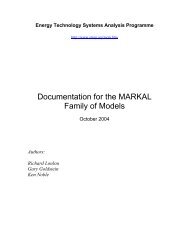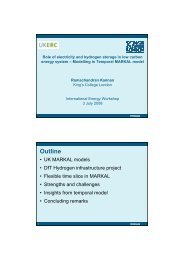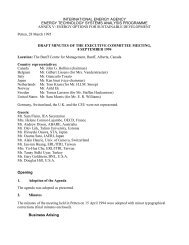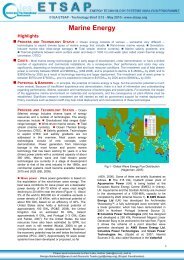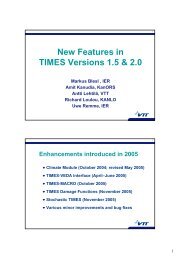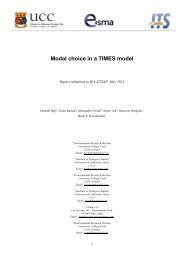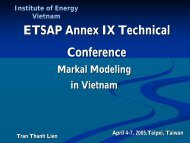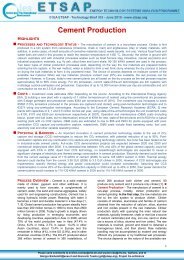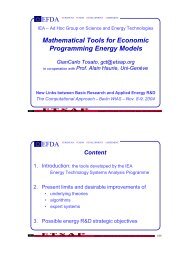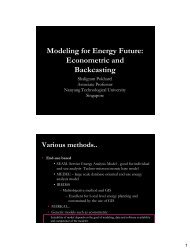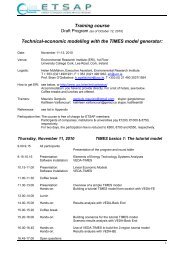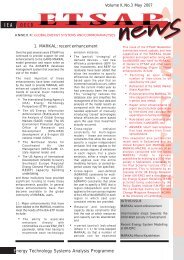Sets and Parameters - iea-etsap
Sets and Parameters - iea-etsap
Sets and Parameters - iea-etsap
Create successful ePaper yourself
Turn your PDF publications into a flip-book with our unique Google optimized e-Paper software.
2 <strong>Sets</strong><br />
<strong>Sets</strong> are used in TIMES to group elements or combinations of elements with the purpose of<br />
specifying qualitative characteristics of the energy system. One can distinguish between onedimensional<br />
<strong>and</strong> multi-dimensional sets. The former sets contain single elements, e.g. the set<br />
prc contains all processes of the model, while the elements of multi-dimensional sets are a<br />
combination of one-dimensional sets. An example for a multi-dimensional set is the set top,<br />
which specifies for a process the commodities entering <strong>and</strong> leaving that process.<br />
Two types of sets are employed in the TIMES framework: user input sets <strong>and</strong> internal sets.<br />
User input sets are created by the user, <strong>and</strong> used to describe qualitative information <strong>and</strong><br />
characteristics of the depicted energy system. One can distinguish the following functions<br />
associated with user input sets:<br />
• definition of the elements or building blocks of the energy system model (i.e. regions,<br />
processes, commodities),<br />
• definition of the time horizon <strong>and</strong> the sub-annual time resolution,<br />
• definition of special characteristics of the elements of the energy system.<br />
In addition to these user sets, TIMES also generates its own internal sets. Internal sets<br />
serve to both ensure proper exception h<strong>and</strong>ling (e.g., from what date is a technology available,<br />
or in which time-slices is a technology permitted to operate), as well as sometimes just to<br />
improve the performance or smooth the complexity of the actual model code.<br />
In the following sections, the user input sets <strong>and</strong> the internal sets will be presented. A<br />
special type of set is an one-dimensional set, also called index, which is needed to build multidimensional<br />
sets or parameters. At the highest level of the one-dimensional sets are the master<br />
or “domain” sets that define the comprehensive list of elements (e.g., the main building<br />
blocks of the reference energy system such as the processes <strong>and</strong> commodities in all regions)<br />
permitted at all other levels, with which GAMS performs complete domain checking, helping<br />
to automatically ensure the correctness of set definition (for instance, if the process name used<br />
in a parameter is not spelled correctly, GAMS will issue a warning). Therefore, before<br />
elaborating on the various sets, the indexes used in TIMES are discussed.<br />
2.1 Indexes (One-dimensional sets)<br />
Indexes (also called one-dimensional sets) contain in most cases the different elements of the<br />
energy model. A list of all indexes used in TIMES is given in Table 2. Examples of indexes<br />
are the set prc containing all processes, the set c containing all commodities or the set all_reg<br />
containing all regions of the model. Some of the one-dimensional sets are subsets of another<br />
one-dimensional set, e.g., the set r comprising the so-called internal model regions is a subset<br />
of the set all_reg which in addition also contains the so-called external model regions 2 . To<br />
express that the set r depends on the set all_reg, the master set all_reg is put in brackets after<br />
the set name r: r(all_r).<br />
The set cg comprises all commodity groups 3 . Each commodity c is considered as a<br />
commodity group with only one element the commodity itself. Thus the commodity set c is a<br />
subset of the commodity group set cg.<br />
Apart from indexes that are under user control, some indexes have fixed elements to serve<br />
as indicators within sets <strong>and</strong> parameters <strong>and</strong> should not be modified by the user (Table 1). The<br />
only exception to this rule is the set prc_grp: while the process groups IRE, NST, PRV,<br />
2 The meaning <strong>and</strong> the role of internal <strong>and</strong> external regions is discussed in Section 2.2.<br />
3 See Section 2.2.1 for a more in-depth treatment of commodity groups.<br />
10



